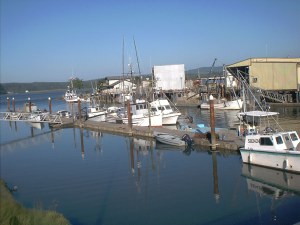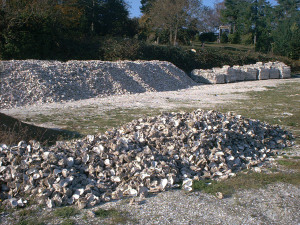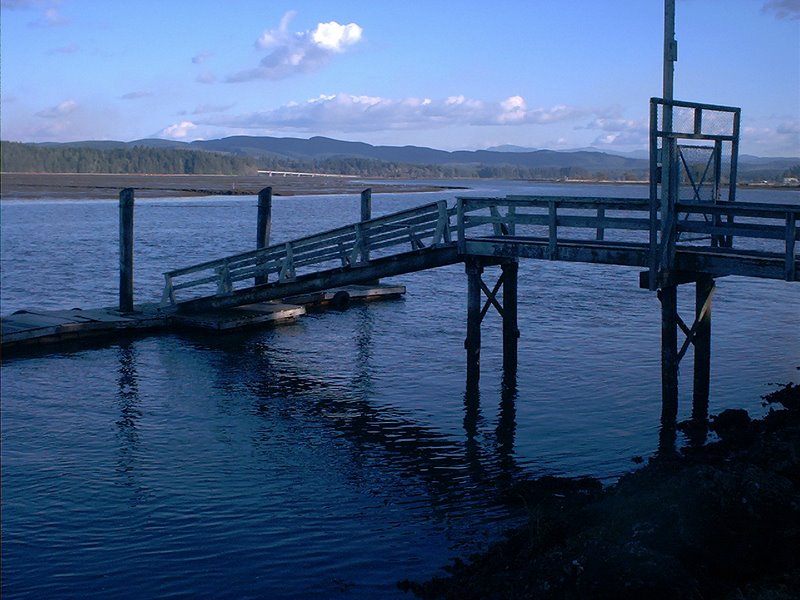
Great Blue Heron
Many say yes to the need to control spartina in Willapa Bay while some say no need to spray chemicals in pristine Willapa Bay to control spartina. I’m paying curious attention, since we are now residents on this wondrous bay. What we have come to take as indicative and a large part of the reason why we chose to put roots down here in the region of Willapa Bay – Willapa Hills – in Pacific County of Washington was the untouched by humans wilderness aspect of life in this area. In the near decade we have lived here, we have learned a bit about the region from our neighbors at work, at church, at home and in the community.
We do not work in the primary industries of timber, commercial fishing, farming, tourism, or small business that make up most of the industry in this region. So we remain always respectful onlookers, observers, if you will, of those who labor in these industries.
Of late though, my attention has been drawn to something that would likely not have been more than passing interest to me were it not for the fact that it is the reality of where we live. More out of curiosity than necessity, I’ve been drawn into doing a bit of looking into the research of others, far more expert than I, on the matter of eco-relationship of life forms who share the Willapa Bay; plant life, marine life, bird refuge, and human life.
We know a bit about the oyster farms, oyster farmers, and commercial fishing industry in the area because they are our neighbors, but also because our employment vocations put us in touch with the ebbs and flows of human economic sustenance in this region. If it isn’t going well for the marine life here, then it isn’t going well for the human life here either. There is a strong interdependence and one in which human stewardship plays an important role. A role seemingly well understood by the people who know and appreciate with respect the history, the immediate present and the future of Willapa Bay.

Oyster farming on Willapa Bay
My (step) father introduced us to awareness of Willapa Bay because he and my mother made almost annual visits here, and both would tell us of their trip that year. One of the things he used to tell us, often and with great pride, was that Willapa Bay was the third largest bay in the country and the most pristine. He was a longshoreman and had at an earlier time in his life, in his younger years worked the docks and boats on Willapa Bay. He passed last year, Jan 2006, and some of his friends may well remember Charlie Ellsworth. He was a guy’s guy kind of man, honest, forthright, sincere, loyal, a veteran and had a strong work ethic. His pride of the Willapa often piqued my interest, but not enough to seek it out and see for myself until one day…..
My husband and I took a planned camping trip ourselves to meet up with my children at Fort Stevens in Warrenton, Oregon. Causing us to drive on Highway 101, through towns of South Bend, Raymond, which we actually had never heard of before and then about 10 miles out of South Bend, was the road sign for Bay Center — the place were my mom and dad took an annual vacation trip. Thus was our introduction to this region of Washington and it was so breath-taking that I wondered aloud if we could transfer our employment here and take up residence here. (We both were employees for State of Washington, Dept. Social and Health Services and can transfer where openings exist in offices in Washington state).
There was one opening, not two, and my husband got himself transferred to South Bend, and we moved here and thus began our life in Willapa. Over the years, as we got acquainted with the area, we knew it was among those considered economically depressed and that while it was not flourishing in terms of human economic development, it was an environmental treasure not yet exploited. Unlike some residents who are generational families living in the area, we are imports – from the city – no less, but we have become very attached to the beauty of the region and feel blessed to have the opportunity to live here.
This was more quiet knowing on my part. Over the years we have lived here, I have only begun to understand how important the region is to Washington state and on a larger scale to other bay, estuary, wilderness communities that have been less cautious in their over development and exploitation of the fragile co-existence that must remain to preserve the quality of life that keeps Willapa Bay the least spoiled estuary environments in North America.
No, this is not me bragging – this is me being astonished at how others, more versed and knowledgeable define Willapa Bay. And that does then, cause me to be proud of where we live, and desire to enter into a stewardship to preserve what is here for future generations to appreciate. Do my grandchildren care deeply whether spartina will overtake the bay and turn it from a mud bay estuary refuge for the thousands of migratory birds? Or will they care if the oyster farmers who have an enormous stake in the condition of the bay will continue to be watchful stewards and keepers of the bay? Will they care – not likely, but if not my grandchildren, than I know some others grandchildren may indeed care – and deeply.
I defer to others more learned than I on the matter, in recognition that I could not begin to acquire that kind of knowlege base beyond that of a reader, listener, and resident here on Willapa Bay. What do I know about burrowing shrimp, ghost shrimp, mud shrimp – native species to Willapa Bay and their impact on oysters – not native to Willapa Bay yet perhaps exactly because of the shepherding of oyster farmers exists Willapa Bay as I have come to know it — as my father said in pride – it is the most pristine bay in the country.

Thalassinidea (ghost shrimp)
What do I know of the plant life spartina, except what I see waving on the shore and in the waters at the beaches where I live on Willapa Bay, in the Palix river that borders Bay Center Dike Road on it’s way to emptying into Willapa Bay. What do I know about the ongoing environmentally controversial matter of whether to use chemical sprays to help (or hinder) the interplay of life that now exists on Willapa Bay and likely needs to continue to remain, if not thrive and flourish on Willapa Bay.

A clump of Spartina alterniflora
I know very little, but I know enough to know that it is worthwhile to remain curious and interested enough to try to follow along as an interested observer, an interested bystander, an interested onlooker. And for that reason, I want to add links like the one below that do a better job of investigative reporting than I could begin to do. My son, attending Oregon State University, not that interested in what happens at Willapa Bay found himself having to learn about geology and with that a study of Willapa Bay. I have come to understand that universities and colleges in both Washington and Oregon continue to study Willapa Bay. I have come to appreciate that Willapa Bay has much to offer as a study in what is working that keeps it what it is; a clean, pristine bay – estuary – mudflats – tidelands – wilderness – refuge.

photo courtesy of Friends of Willapa National Wildlife Refuge
Washington State Magazine
Willapa Bay, also known as Shoalwater, is the largest estuary between San Francisco and Puget Sound. It boasts one of the least-spoiled environments and the healthiest salmon runs south of Canada, produces one in every four oysters farmed in the United States, and is a favorite pit stop for tens of thousands of migratory birds.
And it’s in trouble.
The infestation of Spartina, imported by accident from the East Coast, collects enough silt to raise the bay floor by up to a foot, turning much of Willapa’s enviably productive tidal zone into a giant, unkempt lawn. At the same time, other introduced plants and animals and two opportunistic species of native shrimp also threaten to spoil the pristine bay.
“If you lose Willapa Bay, it’s of both state and national significance,” says Kim Patten (’83 Ph.D. Horticulture), a Washington State University researcher and associate professor of horticulture who is a leader in the battle for the bay.
“I think it’s a national treasure, because every estuary in North America would try to emulate it. There’s no other estuary out there like it,” Patten says. “We have sort of an idyllic estuary. It’s not perfect, but for all intents and purposes, it’s a very functioning estuary. You don’t get better than that.”
Environmentally, aquatic landscapes from Chesapeake Bay to San Francisco Bay are infamous for what they’ve lost. Willapa Bay’s protectors want to make it renowned for what it kept. They’re starting to get noticed.
Last June, the National Audubon Society ranked Willapa Bay second—just behind part of Florida’s Everglades—in its Cooling the Hot Spots report detailing wildlife areas threatened by invasive species. That followed a similar listing in the National Wildlife Refuge Association’s 2002 report, Silent Invasion. And the Nature Conservancy has made protecting the bay and its rich watershed one of its highest Washington priorities.
Senator Patty Murray (’72 Recreation) and her colleagues helped secure another $1 million in federal funding for this season’s work, the second in a six-year, multi-partner plan to eradicate Spartina. The state is pitching in hundreds of thousands more.
“It’s so common for us to not realize what we’ve got until we lost it,” says U.S. Representative Brian Baird, D-Vancouver. “This wonderful bay faces some real threats. Spartina, for example, is a nightmare. It can turn the Willapa Bay into the Willapa Prairie.”
……..
President Franklin D. Roosevelt established Willapa National Wildlife Refuge in 1937 to protect habitat for migrating birds. But as Spartina has thickened, Willapa’s legions of shorebirds have thinned.
Shorebirds flock to unspoiled tidal flats to peck for worms, midges, nematodes, and other critters that make up the “groceries” that fuel the birds’ long migrations along the West Coast. Some also will forage among the stubble and wrack of dead Spartina, but they won’t venture into living meadows where predators might lurk.
“Willapa Bay is one of the few stepping-stones of habitat left for migrating birds from South and Central America to Canada and Alaska,” says Nina Carter, policy director for Audubon Washington. She helped lobby her national organization to train a spotlight on Willapa’s disappearing habitat for short-billed dowitchers and tens of thousands of other shorebirds that migrate through each year.





















